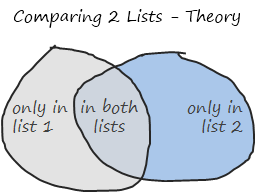Comparison of lists of data is something that we do all the time. Today, lets learn a few tricks that you can apply immediately to compare 2 lists using Excel.
This post discusses how to compare two lists with formula based rules. If you just want to quickly highlight common values, click here.
If you want to compare two tables (based on multiple columns), see this.
We will learn how to compare 2 lists of data in 3 + 1 different ways. (click on links to jump to that section of post)
- Highlight items that are only in first list
- Highlight items that are only in second list
- Highlight items that are in both lists
- Search and highlight matches in both lists – Home Work
Understanding the Comparison Logic:
Whenever you compare 2 sets of values, there are 3 possibilities, as shown in the illustration below:

Apart from looking like circles drawn by hulk with a crayon, these circles show important concepts of set theory in simplest form.
[there is a fourth possibility of a value not being in either lists, we omit that for now]
What you need to compare 2 lists?
1. Of course, you need 2 lists of data. But, just to make formulas simpler and easier to read, lets name the 2 lists as lst1 and lst2.
Lets assume your data looks like this:

2. Also, you should know how to use COUNTIFS Excel Formula, it is so awesome, I wonder why MS hasn’t called it MAGIC() ?
So in order to find-out if a value is in list 1 only, we use a formula like =COUNTIFS(lst2,value)=0.
This checks whether “value” occurs anywhere in lst2 and returns false if that is the case. (it assumes that value is already in lst1).
Highlighting Items that are in First List Only

 Select values in first list (assuming the values are in
Select values in first list (assuming the values are in B21:B29)- Go to conditional formatting > add rule (related: conditional formatting basics)
- Select the rule type as “formula”
- Write a rule like this:
=COUNTIFS(lst2, B21)=0 - Double check the reference and make sure it is relative (and not like $B$21). Select the reference and press F4 repeatedly to change it to relative reference
- Set the formatting you want.
- Click ok.
- All done. You should see values only in first list highlighted.
Highlighting Items that are in Second List Only

- Select values in second list (assuming the values are in
C21:C28) - Go to conditional formatting > add rule (related: conditional formatting basics)
- Select the rule type as “formula”
- Write a rule like this:
=COUNTIF(lst1, C21)=0 - Repeat steps 5-8 as above.
Highlighting Values in Both Lists:

Now, it gets interesting as you should apply conditional formatting individually to both lists.
- Select values in first list (assuming the values are in
B21:B29) - Set the conditional formatting rule as
=COUNTIF(lst2,B21)>0 - Apply formatting as you want.
- Now select second list (assuming the values are in
C21:C28) - Set the conditional formatting rule as
=COUNTIF(lst1,C21)>0 - Again, apply formatting as you want.
- That is all.
Searching for a value and Highlighting Matched Items in Both Lists – Your Homework:
This is another common thing we do. We want to find-out a given value (say in A1) is in the both lists, first list or second list and highlight all the matches. Like this:

Of course, doing this is very straightforward in Excel once you understand the above 3 things. So I am leaving this as your home work.
Go ahead, figure this out, practice it on a workbook. When you are satisfied with your result, post the answers here. Discuss!
Download Example Workbook on Comparing 2 Lists in Excel:
Go ahead and download the example workbook on comparing 2 lists in excel. [download from mirror]
It also contains the answer to homework above. Play with it and become comparison ninja.
How do you compare lists in Excel?
I often have to compare values in multiple lists (for eg. customers of one product vs. another, defect status this month vs. last month etc.). I use formulas to compare with-in table. And if I want to highlight the matches, I use CF.
What about you? How do you compare lists of values in Excel? What formulas do you use? Please share your techniques and tips using comments.

 Select values in first list (assuming the values are in
Select values in first list (assuming the values are in 


















One Response to “How to export YouTube video comments to Excel file? – Free template + Power Query case study”
And I asked myself when i saw your Accouncement Video for the Give away: "Seriously, will Chandoo go manualy thru all his Videos and pick the winners?!". Great connection to the give away with this tutorial 🙂 !